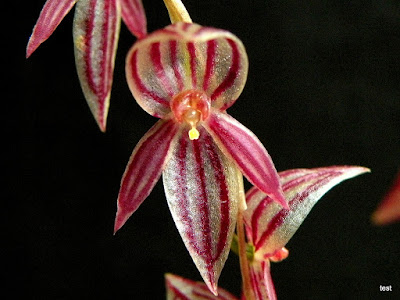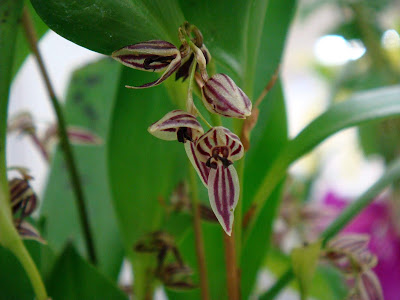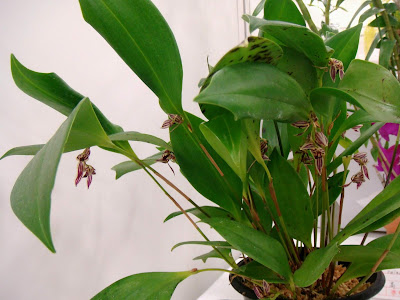Pleurothallis secunda is native to Colombia, Ecuador, Peru and Venezuela. In Venezuela, these plants were found near Caracas in the Federal District, in the states Aragua near Colonia Tovar (at elevations of 2100-2200 m)...
Pleurothallis secunda also called as The One-Sided Bloom Pleurothallis, Humboldtia secunda, Humboltia secunda, is a species of the genus Pleurothallis. This species was described by Eduard Friedrich Poeppig & Stephan Ladislaus Endlicher in 1836.
IDENTIFY PLEUROTHALLIS SECUNDA
Pleurothallis secunda is native to Colombia, Ecuador, Peru and Venezuela. In Venezuela, these plants were found near Caracas in the Federal District, in the states Aragua near Colonia Tovar (at elevations of 2100-2200 m), Lara near Sanare (at elevations of 1500 m), Mérida in several places (at elevations of 2600-3400 m) and Trujllo (at elevations of 2700-3200 m).
It is a small to just medium sized, warm to cold growing epiphyte with caespitose, terete, slender, to stout, 7-80 cm long ramicauls enveloped basally by 2 to 4 tubular sheaths and carrying a single, apical, erect, elliptic or oblong, acute to shortly acuminate, coriaceous, 9-30 cm long and 2-13 cm wide leaf.
The One-Sided Bloom Pleurothallis blooms in the spring on a 1-2 suberect to arching, lax, to 20 cm long, simultaneously several-flowered inflorescence with tubular floral bracts that holds the non-resupinate flowers out and away from midleaf. The flowers are 1.5 cm in diameter. The lower petal of this species is the lowest, and the side outer petals form a hood over the lip and the brim, have bright petals of the outer whorl, transparently yellow-green, with longitudinal veins in the pinkish-brown color. The inner coat flakes are more transparently yellow than the petals of the outer whorl and have a red coloration at the apexes. The lip is fleshy, bright yellow, the stump is dirty white, and the chamber cover is white with a yellow triangle at the base.
PLEUROTHALLIS SECUNDA CARE AND CULTURE
Cultural information should only be used as a guide, and should be to be adapted to suit you. Your physical location; where you grow your plants, how much time you have to devote to their care, and many other factors, will need to be taken into account. Only then can you decide on the cultural methods that best suit you and your plants.
Light:
Pleurothallis secunda needs a light level of 18000-25000 lux. The light should be slightly filtered or scattered, and the plants should never be exposed to the direct sunlight of the midday sun. Strong air movement should be ensured all the time.
Temperature:
The average temperature of the summer day is 19-21 ° C, night 10 ° C, and the daily difference is 9-11 ° C. The average temperature of the winter day is 18-19 ° C, the night 8-9 ° C, and the daily difference is 10 ° C.
Humidity:
For most of the year, The One-Sided Bloom Pleurothallis needs the average humidity of 80%, it drops to almost 75% for a few months at the end of summer and at the beginning of autumn, after which it increases to almost 85% in the period of late winter and the beginning of spring.
Substrate, growing media:
These plants are usually grown in pots or baskets using a loose, quickly drying substrate, such as bark or chopped woody fern fiber. Perlite addition is also used, which relaxes the substrate, but also retains some of the moisture. The addition of charcoal also improves the properties of the substrate and prevents its souring.
Repotting:
Pleurothallis secunda wrongly tolerate the start of the root ball, so repotting and dividing should only be done when absolutely necessary. However, since the roots do not tolerate the unfolded substrate, the plants should be repotted immediately when the substrate begins to decompose. Therefore, it is better to use tree ferns in the ground, because this decomposes very slowly.
Repotting can be done when new roots begin to grow, because then the plant will stabilize quickly. After division, sometimes it takes up to 2 years for the plant to stabilize.
Watering:
Precipitation is moderate to heavy for most of the year, but the period of several winter months is slightly less rainfall. The plants should often be watered during active growth, but the substrate around the roots can never be soggy or damp.
Fertilizer:
It is recommended to apply a 1/4-1/2 dose of orchid fertilizer weekly. You can use a balanced fertilizer throughout the year, but also can use high-nitrogen fertilizer from spring to autumn and then the high-phosphorus fertilizer until the end of autumn.
Rest period:
In winter, Pleurothallis secunda need to slightly reduce the amount of water, especially those grown in a dark, short day at moderate latitudes. However, they can never dry up completely. Fertilization should be reduced or eliminated until spring, when more watering is undertaken.














COMMENTS